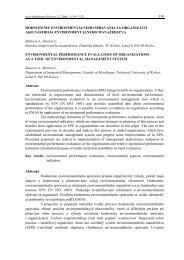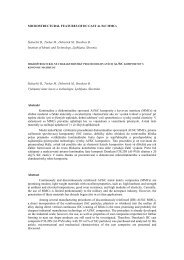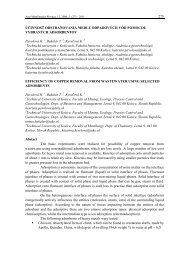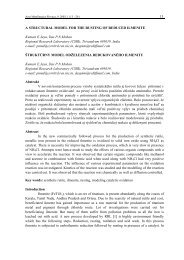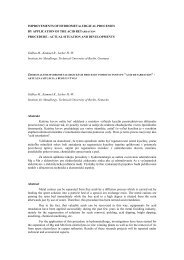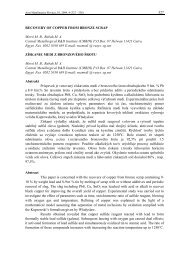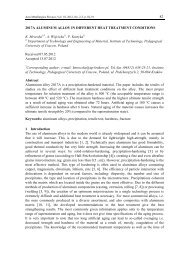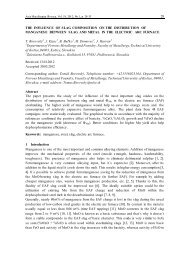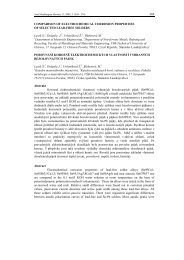199 mathematical modeling of mold-filling and solidification - Acta ...
199 mathematical modeling of mold-filling and solidification - Acta ...
199 mathematical modeling of mold-filling and solidification - Acta ...
Create successful ePaper yourself
Turn your PDF publications into a flip-book with our unique Google optimized e-Paper software.
<strong>Acta</strong> Metallurgica Slovaca, 15, 2009, 3 (<strong>199</strong> - 207) 202<br />
For the incompressible solution algorithm the following equation is used:<br />
dρ 1<br />
=<br />
dP β<br />
where β is the bulk modulus.<br />
e) The dissipation rate equation for NKE - (New k-ε Model) is given by:<br />
∂( ρε ) ∂( ρuε<br />
) ∂( ρvε<br />
) ∂( ρwε<br />
) ∂ ⎛ µ ⎞ ⎛ ⎞ ⎛ ⎞<br />
+ + + = ⎜ t ∂ε<br />
∂ µ<br />
⎟ +<br />
+ ⎜ ⎟<br />
⎜ t ∂ε<br />
∂ µ<br />
⎟ t ∂ε<br />
+<br />
∂t<br />
∂x<br />
∂y<br />
∂z<br />
∂x<br />
⎝ σ ε ∂x<br />
⎠ ∂y<br />
⎝ σε ∂y<br />
⎠ ∂z<br />
⎝ σ ε ∂z<br />
⎠<br />
2<br />
ε ε Cµ<br />
(1 C3)<br />
β1ρκ<br />
⎛ ∂T<br />
∂T<br />
∂T<br />
⎞<br />
C1ε<br />
µ t Φ C2ρ<br />
+<br />
⎜ g x + g y + g z<br />
⎟<br />
κ κ σ t ⎝ ∂x<br />
∂y<br />
∂z<br />
⎠<br />
(5)<br />
The new functions; deformation tensor S ij , <strong>and</strong> the antisymetric tensor W ij , are based<br />
on the velocity components u k in the flow field.<br />
1<br />
Sij<br />
= ( ui,<br />
j + u j,<br />
i )<br />
2<br />
Wij<br />
= 1<br />
( ui,<br />
j − u j,<br />
i ) + Cµ Ω mε<br />
mij<br />
2<br />
where, C µ , is the turbulent constant; Ω m is the angular velocity <strong>of</strong> the coordinate system <strong>and</strong> ε mij<br />
is the alternating tensor operator.<br />
The invariants are:<br />
η = κ<br />
2S ij S ij <strong>and</strong> κ<br />
ξ =<br />
ε<br />
2W ij<br />
ε<br />
Wij<br />
C 1<br />
µ =<br />
, ⎛ η<br />
2 2<br />
4 + 1.5 η + ξ<br />
⎟ ⎞<br />
C 1ε<br />
= max ⎜C1M<br />
⎝ η + 5 ⎠<br />
where, C 1ε , C 2 , σ k , σ ε , σ t , C 3 , C 4 , C 1M <strong>and</strong> β 1 are constants.<br />
2.2 Free surface <strong>modeling</strong><br />
In the last years due to s<strong>of</strong>tware <strong>and</strong> hardware technological evolutions, intensive<br />
studies <strong>and</strong> applications concerning the <strong>mold</strong> <strong>filling</strong> by metallic fluids can be found in the<br />
literature. During the <strong>mold</strong> <strong>filling</strong> process, liquid metal <strong>and</strong> air coexist in the <strong>mold</strong> <strong>and</strong> the<br />
interface position changes rapidly with time [13]. It is essential to introduce a free-surfacetracking<br />
algorithm to analyze the <strong>filling</strong> process. The Volume <strong>of</strong> Fluid Method (VOF) is the<br />
most widely used method for free-surface tracking during <strong>mold</strong> <strong>filling</strong> [13]. In a three<br />
dimensional rectangular coordinate frame, the transport equation on the VOF, F(r,t), for an<br />
incompressible fluid can be written as:<br />
∂ F r<br />
+ ∇ F.<br />
v = 0<br />
∂ t<br />
(6)<br />
The F(r,t) function governed by the above equation is unity in the region occupied by<br />
the fluid <strong>and</strong> zero in the empty region. For the given computational domain, the F(r,t) field



